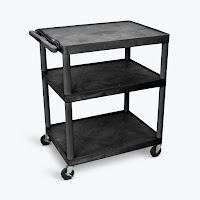Buying Guide: Presentation Stands
As technology advances, so too do means of communication. Gone are the days when you need to print out tons of presentation materials just to present reports. Nowadays, modern professionals can give out presentations to small or large audiences by simply preparing a PowerPoint presentation and plugging their laptops into projectors.
And if you’ve ever sat down and listened to modern presentations or experienced being a presenter yourself, you most probably have encountered technical difficulties. They’re frustrating, to say the least.
But here’s one solution to prevent these problems: a presentation stand.
A presentation stand, also known as a podium, lectern, or presentation station, is a piece of office furniture that’s designed to hold audiovisual equipment during presentations. Its features and design make it an indispensable part of collaborative spaces.
Now, if you look up presentation stands on the web, you might find tons of options for the “best presentation stands”—and it can be overwhelming to choose just one.
So before you add that presentation stand to your shopping cart, you might want to consider these factors when buying the best one for your office or school.
Most of the high-quality presentation stations on the market today are constructed with powder-coated steel and injection-molded thermoplastic resin. They’re some of the most common materials used for presentation stands, mainly because of their durability and wear resistance.
So if you want one that can last for a lifetime of use, check its material first to see if it is truly sturdy and long-lasting.
That said, you have to get a presentation stand with wheels and locking brakes. With this kind of presentation stand, you can easily wheel off your AV equipment from one place to another, lock it in place during meetings, and store it away when not in use.
Apart from a working surface on top, some presentation stands have shelves, drop-leaf side shelves for a more spacious working surface, sliding trays for keyboards or laptops, and even locking vented cabinets to protect AV equipment from theft. These storage spaces can help you easily keep your projectors, laptops, documents, speakers, and other presentation tools secured and organized.
And if that isn’t enough, well-designed presentation stands come with built-in cable management systems, so you can keep your cables organized and prevent accidental trips and falls.
And if you’ve ever sat down and listened to modern presentations or experienced being a presenter yourself, you most probably have encountered technical difficulties. They’re frustrating, to say the least.
But here’s one solution to prevent these problems: a presentation stand.
A presentation stand, also known as a podium, lectern, or presentation station, is a piece of office furniture that’s designed to hold audiovisual equipment during presentations. Its features and design make it an indispensable part of collaborative spaces.
Now, if you look up presentation stands on the web, you might find tons of options for the “best presentation stands”—and it can be overwhelming to choose just one.
So before you add that presentation stand to your shopping cart, you might want to consider these factors when buying the best one for your office or school.
Material
As with most products, a presentation stand may be worth buying if it’s made of a sturdy material.Most of the high-quality presentation stations on the market today are constructed with powder-coated steel and injection-molded thermoplastic resin. They’re some of the most common materials used for presentation stands, mainly because of their durability and wear resistance.
So if you want one that can last for a lifetime of use, check its material first to see if it is truly sturdy and long-lasting.
Mobility
What makes modern working and learning environments different from old ones is one key feature: versatility. To accommodate today’s collaborative spaces, most presentation stands are designed to be mobile.That said, you have to get a presentation stand with wheels and locking brakes. With this kind of presentation stand, you can easily wheel off your AV equipment from one place to another, lock it in place during meetings, and store it away when not in use.
Storage
Keeping your AV equipment organized is essential in preventing technical difficulties. Luckily, presentation stands offer tons of storage for every piece of your equipment.Apart from a working surface on top, some presentation stands have shelves, drop-leaf side shelves for a more spacious working surface, sliding trays for keyboards or laptops, and even locking vented cabinets to protect AV equipment from theft. These storage spaces can help you easily keep your projectors, laptops, documents, speakers, and other presentation tools secured and organized.
And if that isn’t enough, well-designed presentation stands come with built-in cable management systems, so you can keep your cables organized and prevent accidental trips and falls.

Comments
Post a Comment